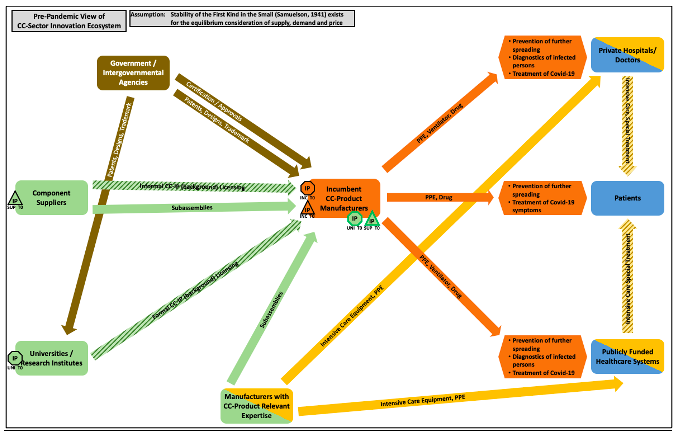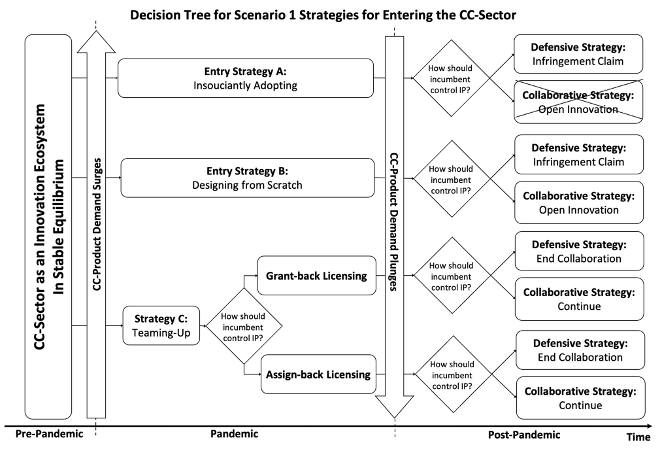Submitted by Leonidas Aristodemou on Wed, 21/10/2020 - 11:47
© Alexander Moerchel*, Frank Tietze, Leonidas Aristodemou, Pratheeba Vimalnath (2020)
*Corresponding author. Please send comments to: amm211@cam.ac.uk
Abstract: The Covid-19 pandemic exposed firms, organisations and their respective supply chains which are directly involved in the manufacturing of products that are critical to alleviating the effects of the health crisis, collectively referred to as the Crisis-Critical Sector,to unprecedented challenges. Firms from other sectors, such as automotive, luxury and home appliances, have rushed into the Crisis-Critical Sector in order to support the effort to upscale incumbent manufacturing capacities, thereby introducing Intellectual Property (IP) related dynamics and challenges. We apply an innovation ecosystem perspective on the Crisis-Critical Sector and adopt a novel visual mapping approach to identify IP associated challenges and IP specific dynamic developments during and potentially beyond the crisis.In this paper, we add methodologically by devising and testing a visual approach to capturing IP related dynamics in evolving innovation ecosystems and contribute to literature on IP management in the open innovation context by proposing paraground IP as a novel IP type.Finally, we also deduce managerial implications for IP management practitioners at both incumbent firms and new entrants for navigating innovation ecosystems subject to crisis-induced dynamic shifts.
Keywords: intellectual property, Innovation ecosystem, open innovation, Covid-19 pandemic, visual language
A pandemic is characterized as a global health crisis that calls for urgent imminent large-scale action by governments, industrial players, as well as a range of other societal actors, whereas governments typically take centre stage to orchestrate rapid responses. Amongst the many challenges during a pandemic, innovation stakeholders and manufacturing firms suddenly find themselves engaged in new relationships, possibly even with competitors, in the effort to find solutions alleviating the pandemic. Those stakeholders are thus likely to face intellectual property (IP) related challenges. To governmental decision makers these challenges might not appear to be of paramount urgency compared to the many huge operational challenges to deploy urgently needed resources. However, if IP related challenges are not addressed early during the pandemic, they may hinder innovation stakeholders to effectively collaborate, thus causing delays to the effective mobilisation of urgently needed resources (Nicholson et al., 2020).
Based on the close observations by Tietze et al. (2020, 2020a) during the early phases of the COVID-19 pandemic, we uncover pandemic induced IP related challenges and deduce a set of managerial implications and recommendations for IP practitioners at newly collaborating innovation stakeholders. More specifically, we advance and model Tietze et al. (2020a)'s scenario in which industrial manufacturers enter Crisis-Critical(CC)-Sector from outside, defined as Type 1 New Entrants, with one of three strategies (see Table on right): (A) insouciantly adopting features of incumbent CC-Products by copying or reverse-engineering without conducting freedom-to-operate analysis; (B) designing CC-Products from the ground up using own competence and expert advice, thereby potentially developing their own CC-IP, but without ensuring proper freedom-to-operate also risking infringement claims, or (C) teaming up with incumbent CC-Product manufacturer thereby licensing in CC-IP.
We apply an innovation ecosystem perspective to the CC-Sector and adopt a novel visual mapping approach to identify IP associated challenges and IP specific dynamic developments during and potentially beyond the crisis (see Figure on the right, as an example application of the visual mapping approach to the CC-Sector innovation ecosystem). We add methodologically by devising and testing a visual approach to capturing IP related dynamics in evolving innovation ecosystems and contribute to literature on IP management in the open innovation context by proposing paraground IP as a novel IP type. This study is relevant to decision makers and negotiators who represent incumbent and new entrant firms in CC-sectors as the crisis situation evolves.
Our results indicate that IP practitioners at both incumbent and new entrant firms to the CC-Sector face IP related dynamics and resulting challenges, as well as uncertainties, regardless of the type of new entrant firm and which entry strategy is chosen. More specifically, we discovered that following a defensive counter strategy by filing an infringement claim against Type 1 New Entrants may not be a fruitful option for incumbent firms as it may expose them to the risk of high litigation costs not being recouped or even failing altogether, on one hand, and may permanently deny incumbent firms’ access to potentially valuable complementary background IP and newly developed CC-IP owned by Type 1 New Entrants, on the other hand. Furthermore, when instead pursuing a collaborative approach, incumbent firms might consider to assert assign-back clauses in cross-licensing agreements in order to, for example, quickly accumulate a sizeable portfolio of CC-IP (background) while sharing the cost of its development, to avoid risks of shared CC-IP ownership, and to build up leverage for the next round of cross-licensing negotiations. Our study also shows that Type 1 New Entrants typically make considerable investments to enter the CC-Sector in order to help in the effort to meet the positive demand shock for CC- Products at the start of the pandemic. In order to recover these costs, new entrant firms ought to conduct a freedom-to-operate analysis as early as possible, particularly when following entry strategies (A) and (B), in order to mitigate the risk of infringement claims by incumbent firms pursuing a defensive counter strategy. Furthermore, when entering into cross-licensing agreements with incumbent firms, particularly in entry strategies (B) and (C), it would be prudent for Type 1 New Entrants to insist on a grant-back clause because it would, for instance, allow them to retain ownership of their endogenously and newly developed CC-IP that potentially underlie valuable CC-Product enhancements that are desirable to incumbent firms. This, in turn, leaves new entrant firms enough leverage over incumbent firms to potentially negotiate lower royalties and less confining scope restriction clauses during the next round of cross-licensing negotiations. Ultimately, results indicate that the threat of Type 1 New Entrants permanently establishing themselves as competing actors in the CC-Sector is particularly high in the entry strategy (B) scenario and exists to some extent also in entry strategy (C).
We believe that the CC-IP-related policy implications discovered by observing unfolding IP-related dynamics during the early stages of the Covid-19 pandemic in the respective CC-Sector innovation ecosystem are relevant to other pandemic settings. Furthermore, our deductions and recommendations should help IP practitioners to ensure effective collaboration among innovation stakeholders directly involved in finding solutions to the pandemic. We provide a summary decision tree for scenario 1 strategies for entering the CC-Sector (see Figure on the right).
Working paper article:
Moerchel, A., Tietze, F., Aristodemou, L., & Vimalnath, P., 2020. Identifying Crisis-Critical Intellectual Property Challenges during the Covid-19 Pandemic: A scenario analysis and conceptual extrapolation of innovation ecosystem dynamics using a visual mapping approach. Centre for Technology Management (CTM) Working Paper Series, October 2020 (1), pp. 1-54. https://doi.org/10.17863/CAM.58372
References
Brooks, C. and Flores, D. (2020) Ventec Life Systems and GM Partner to Mass Produce Critical Care Ventilators in Response to COVID-19 Pandemic, GM Corporate Newsroom (Accessed: 3 September 2020).
F. Hoffmann-La Roche AG (2020) Roche’s cobas SARS-CoV-2 Test to detect novel coronavirus receives FDA Emergency Use Authorization, analytica-world.com (Accessed: 13 August 2020).
Jack, S. (2020) Coronavirus: Government orders 10,000 ventilators from Dyson, BBC News. (Accessed: 13 August 2020).
Ma, A. (2020) NC textile mill ‘heeds call of nation,’ gears up to make 10 million face masks per week, The Charlotte Observer. (Accessed: 13 August 2020).
Manero, A. et al. (2020) ‘Leveraging 3D printing capacity in times of crisis: Recommendations for COVID-19 distributed manufacturing for medical equipment rapid response’, International Journal of Environmental Research and Public Health, 17(13), pp. 1–17. doi: 10.3390/ijerph17134634.
Nicholson P. et al. (2020) ‘Knowledge transfer for large-scale vaccine manufacturing’, Science, 369(6506), pp. 912–914. doi: 10.1126/science.abc9588
Pays, C. (2020) The beauty industry is rallying to fight Covid-19, Vogue. (Accessed: 13 August 2020).
Richards, G. (2020) Project Pitlane: how rival F1 teams united in battle against Covid-19, The Guardian (Accessed: 13 August 2020).
Tietze, F. et al., (2020a) ‘Crisis-Critical Intellectual Property: Findings From the COVID-19 Pandemic’, IEEE Transactions on Engineering Management, pp. 1–18. doi: 10.1109/TEM.2020.2996982.
Tietze, F. et al., 2020. Crisis-Critical Intellectual Property: Findings from the COVID-19 Pandemic. Centre for Technology Management (CTM) Working Paper Series, April 2020 (2), pp. 1-18. https://doi.org/10.17863/CAM.51142 ; http://dx.doi.org/10.2139/ssrn.3569282



